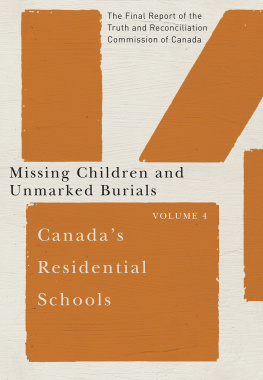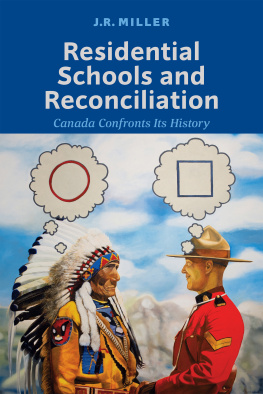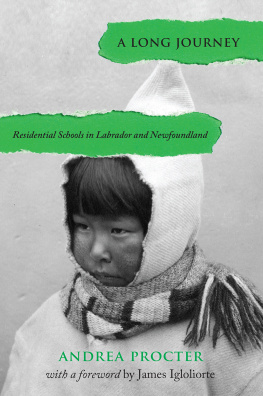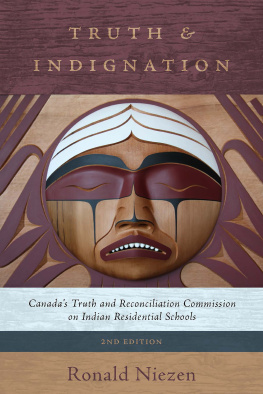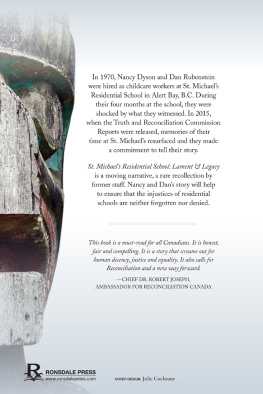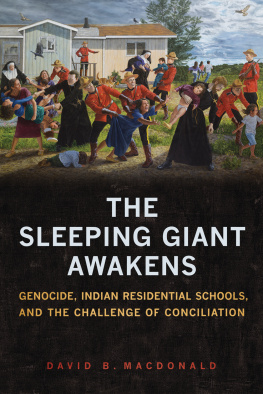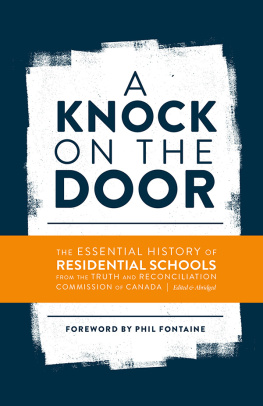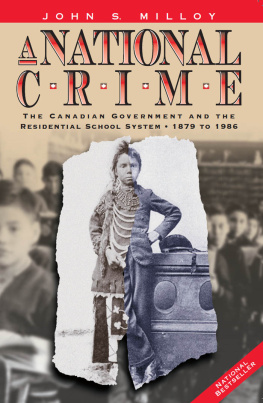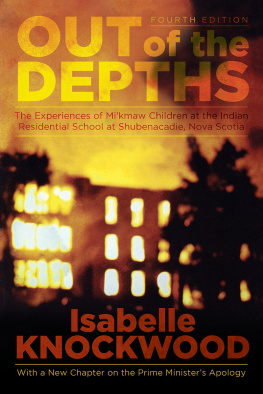Canadas Residential Schools
Volume 4

Canadas Residential Schools:
Missing Children and Unmarked Burials

The Final Report of the Truth and Reconciliation Commission of Canada
Volume 4
Published for the
Truth and Reconciliation Commission
by
McGill-Queens University Press
Montreal & Kingston London Chicago
This report is in the public domain.
Anyone may, without charge or request for permission, reproduce all or part of this report.
2015
Truth and Reconciliation Commission of Canada
Website: www.trc.ca
| ISBN 978-0-7735-4657-8 (v. 4 : bound). | ISBN 978-0-7735-4658-5 (v. 4 : paperback). |
Printed in Canada on acid-free paper
McGillQueens University Press acknowledges the support of the Canada Council for the Arts for our publishing program. We also acknowledge the financial support of the Government of Canada through the Canada Book Fund for our publishing activities.
Library and Archives Canada Cataloguing in Publication
Truth and Reconciliation Commission of Canada
[Canadas residential schools]
Canadas residential schools : the final report of the Truth and Reconciliation Commission of Canada.
(McGillQueens Native and northern series ; 8086)
Includes bibliographical references and index.
Contents: v. 1. The history. Part 1, origins to 1939 The history. Part 2, 1939 to 2000 v. 2. The Inuit and northern experience v. 3. The Mtis experience v. 4. The missing children and unmarked burials report v. 5. The legacy v. 6. Reconciliation
| Issued in print and electronic formats. |
| ISBN 978-0-7735-4649-3 (v. 1, pt. 1 : bound). | ISBN 978-0-7735-4650-9 (v. 1, pt. 1 : paperback). |
| ISBN 978-0-7735-4651-6 (v. 1, pt. 2 : bound). | ISBN 978-0-7735-4652-3 (v. 1, pt. 2 : paperback). |
| ISBN 978-0-7735-4653-0 (v. 2 : bound). | ISBN 978-0-7735-4654-7 (v. 2 : paperback). |
| ISBN 978-0-7735-4655-4 (v. 3 : bound). | ISBN 978-0-7735-4656-1 (v. 3 : paperback). |
| ISBN 978-0-7735-4657-8 (v. 4 : bound). | ISBN 978-0-7735-4658-5 (v. 4 : paperback). |
| ISBN 978-0-7735-4659-2 (v. 5 : bound). | ISBN 978-0-7735-4660-8 (v. 5 : paperback). |
| ISBN 978-0-7735-4661-5 (v. 6 : bound). | ISBN 978-0-7735-4662-2 (v. 6 : paperback). |
| ISBN 978-0-7735-9817-1 (v. 1, pt. 1 : ePDF). | ISBN 978-0-7735-9818-8 (v.1, pt. 1 : ePUB). |
| ISBN 978-0-7735-9819-5 (v. 1, pt. 2 : ePDF). | ISBN 978-0-7735-9820-1 (v. 1, pt. 2 : ePUB). |
| ISBN 978-0-7735-9821-8 (v. 2 : ePDF). | ISBN 978-0-7735-9822-5 (v. 2 : ePUB). |
| ISBN 978-0-7735-9823-2 (v. 3 : ePDF). | ISBN 978-0-7735-9824-9 (v. 3 : ePUB). |
| ISBN 978-0-7735-9825-6 (v. 4 : ePDF). | ISBN 978-0-7735-9826-3 (v. 4 : ePUB). |
| ISBN 978-0-7735-9827-0 (v. 5 : ePDF). | ISBN 978-0-7735-9828-7 (v. 5 : ePUB). |
| ISBN 978-0-7735-9829-4 (v. 6 : ePDF). | ISBN 978-0-7735-9830-0 (v. 6 : ePUB) |
1. Native peoplesCanadaResidential schools. 2. Native peoplesEducationCanada.
3. Native peoplesCanadaGovernment relations. 4. Native peoplesCanadaSocial conditions.
5. Native peoplesCanadaHistory. I. Title. II. Series: McGillQueens Native and northern series ; 8086
| E96.5.T78 2016 | 971.00497 | C2015-905971-2
C2015-905972-0 |
Executive summary
T he Truth and Reconciliation Commission of Canadas Missing Children and Unmarked Burials Project is a systematic effort to record and analyze the deaths at the schools, and the presence and condition of student cemeteries, within the regulatory context in which the schools were intended to operate. The projects research supports the following conclusions:
The Commission has identified 3,200 deaths on the Truth and Reconciliation Commissions Register of Confirmed Deaths of Named Residential School Students and the Register of Confirmed Deaths of Unnamed Residential School Students.
For just under one-third of these deaths (32%), the government and the schools did not record the name of the student who died.
For just under one-quarter of these deaths (23%), the government and the schools did not record the gender of the student who died.
For just under one-half of these deaths (49%), the government and the schools did not record the cause of death.
Aboriginal children in residential schools died at a far higher rate than school-aged children in the general population.
For most of the history of the schools, the practice was not to send the bodies of students who died at schools to their home communities.
For the most part, the cemeteries that the Commission documented are abandoned, disused, and vulnerable to accidental disturbance.
The federal government never established an adequate set of standards and regulations to guarantee the health and safety of residential school students.
The federal government never adequately enforced the minimal standards and regulations that it did establish.
The failure to establish and enforce adequate regulations was largely a function of the governments determination to keep residential school costs to a minimum.
The failure to establish and enforce adequate standards, coupled with the failure to adequately fund the schools, resulted in unnecessarily high death rates at residential schools.
These findings are in keeping with statements that former students and the parents of former students gave to the Commission. They spoke of children who went to school and never returned. The tragedy of the loss of children was compounded by the fact that burial places were distant or even unknown. Many Aboriginal people have unanswered questions about what happened to their children or relatives while they were attending residential school. The work that the Commission has begun in identifying and commemorating those students who died at school and their gravesites needs to be finished.
The work that the Commission has commenced is far from complete. The National Residential School Student Death Register established by the Truth and Reconciliation Commission of Canada represents the first national effort to record the names of the students who died at school. There is a need for continued work on the register: there are many relevant documents that have yet to be reviewed. There is a need for the development and implementation of a national strategy for the documentation, maintenance, commemoration, and protection of residential school cemeteries. Such a program, carried out in close consultation with the concerned Aboriginal communities, is necessary to properly honour the memory of the children who died in Canadas residential schools.
Introduction
Death cast a long shadow over Canadas residential schools. In her memoir of her years as a student at the QuAppelle, Saskatchewan, school in the early twentieth century, Louise Moine wrote of one year when tuberculosis was rampaging through the school.
There was a death every month on the girls side and some of the boys went also. We were always taken to see the girls who had died. The Sisters invariably had them dressed in light blue and they always looked so peaceful and angelic. We were led to believe that their souls had gone to heaven, and this would somehow lessen the grief and sadness we felt in the loss of one of our little schoolmates.

